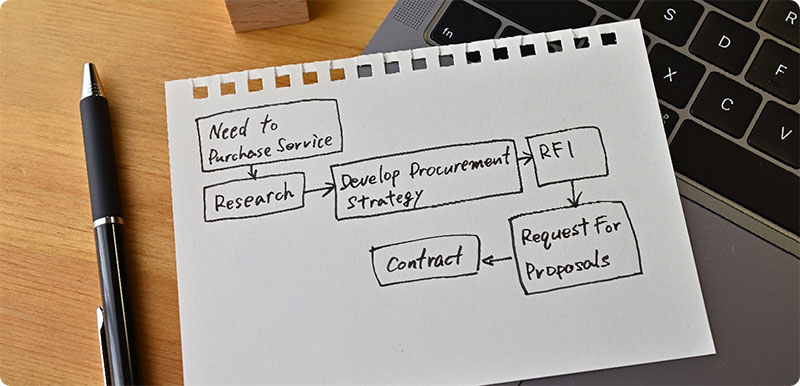RESOURCES
THE ART OF CRAFTING A COMPELLING RFP: KEY ELEMENTS FOR SUCCESS

INTRODUCTION
An effective procurement process is fundamentally reliant on the creation of a persuasive Request for Proposal (RFP) document. This pivotal piece of communication not only outlines the specifics of the project, but also sets the stage for the subsequent relationship with potential suppliers. As such, constructing an RFP that draws the right suppliers can greatly affect the quality of proposals, negotiations, and ultimately, project outcomes. This article delves into the nuances of crafting a compelling RFP, exploring the key components that can drive success and guide the creation of an exceptional RFP document.
UNDERSTANDING THE RFP: A FRAMEWORK FOR INTERACTION
At its core, an RFP is a business document used to initiate a transactional relationship. But beyond this basic definition, it plays a role in forming an interactive bridge between an organization and its potential suppliers. The RFP outlines a project's scope, deadlines, and requirements, serving as an open invitation for suppliers to devise and present their most suitable and competitive solutions. It sets the tone for supplier interaction, shaping perceptions of the project and the professionalism of your organization.

ELEMENTS OF AN EXCEPTIONAL RFP: BEYOND THE BASICS
A superior RFP goes beyond the basic requisites, weaving together several elements to form a comprehensive, engaging document. The following components are crucial to crafting an RFP that resonates with potential suppliers and garners high-quality responses:
Executive Summary:
This section should succinctly encapsulate the project's primary objectives, the organization's expectations from potential suppliers, and the underlying purpose of the RFP. It serves as the first impression, and thus, should clearly communicate the crux of the project and its significance.
Organization and Project Background:
In-depth information about your organization and the project is crucial to provide context. Discuss your organization's history, culture, values, and achievements. Explain the project's motivations, objectives, and intended impact. This backstory helps suppliers understand the project's broader context and align their proposals accordingly.
Detailed Project Description:
Here, outline the project specifics, including its purpose, objectives, deliverables, and timeline. Also, define the project's success metrics. This clarity allows suppliers to understand the project's depth and breadth, enabling them to craft fitting proposals.
Scope of Work:
In this section, offer a clear and precise outline of the project's scope, including all the tasks, services, or goods required. Detail the responsibilities, deliverables, and timelines, providing a well-defined path that the supplier is expected to tread.
Proposal Submission Requirements:
Specify what suppliers should include in their proposal, including the structure, content, and presentation format. This standardization allows for easier comparison between different proposals.
Evaluation Criteria:
Make sure to outline how you plan to evaluate proposals. List the metrics you'll use to compare bids, such as price, experience, methodology, or innovation. Transparent criteria ensure a fair, unbiased selection process.
Contractual Terms and Conditions:
This section should present the terms and conditions of the contract, including pricing structure, payment terms, contract duration, termination conditions, and any legal or regulatory compliances. This transparency prevents any future disputes or misunderstandings.

THE CRITICAL ROLE OF CLARITY AND DETAIL
Creating an exceptional RFP is rooted in achieving a balance between clarity and detail. Ambiguity and omissions can cause misunderstandings, resulting in inadequate proposals and potential roadblocks during project execution. Your RFP should offer clear, detailed information about all aspects of the project, creating a roadmap for potential suppliers.
LANGUAGE AND TONE: THE SUBTLE PERSUADERS
The language and tone of your RFP significantly influence its reception by potential suppliers. Use professional, concise, and clear language, avoiding unnecessary jargon. The tone should be cordial and respectful, fostering a sense of collaboration. An approachable RFP encourages quality suppliers to engage.
ENCOURAGING DIALOGUE: THE POWER OF INTERACTION
Inviting potential suppliers to ask questions can refine their understanding of the project and result in more tailored proposals. Incorporate a section dedicated to inquiries, outlining a timeline and process for queries and responses. This initiative promotes transparency and paves the way for constructive dialogues.
CONCLUSION
Creating an RFP that is both compelling and comprehensive is a strategic endeavor requiring careful thought, meticulous detail, and a deep understanding of the project and its requirements. It involves more than merely outlining the project—it's about communicating its vision, setting the stage for fruitful collaborations, and driving procurement success. By integrating the key elements shared in this article, procurement professionals can hone their RFP writing skills, crafting documents that attract high-quality, suitable suppliers, fostering successful project outcomes. This valuable skill is an indispensable tool in the procurement professional's arsenal, a masterstroke that can significantly elevate the efficacy of the procurement process.







